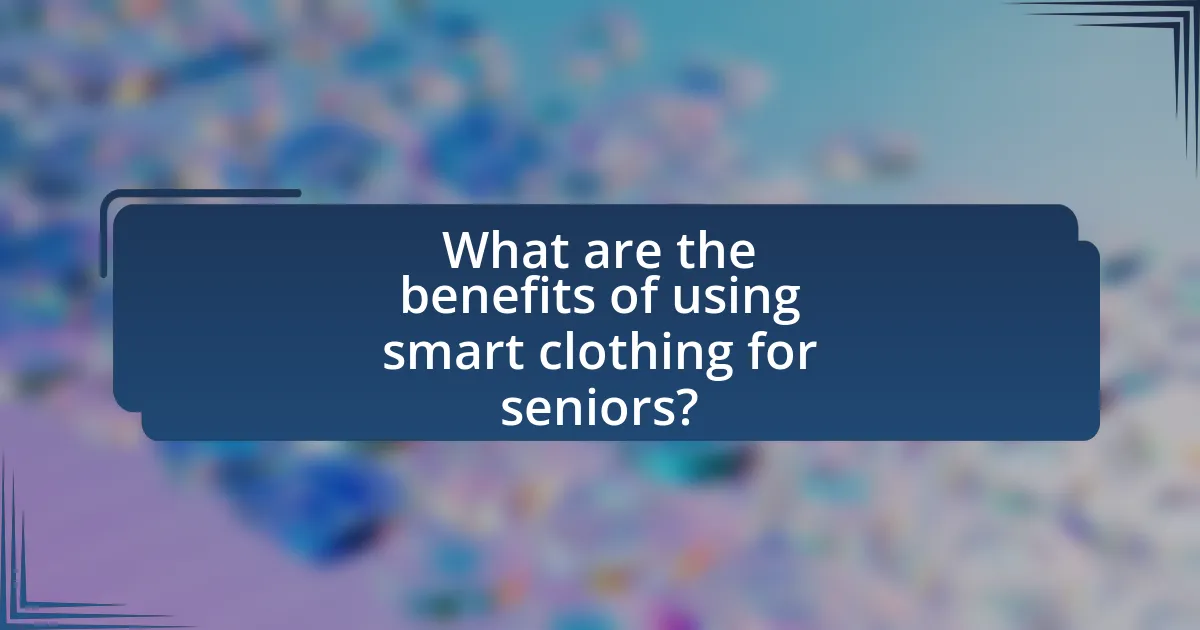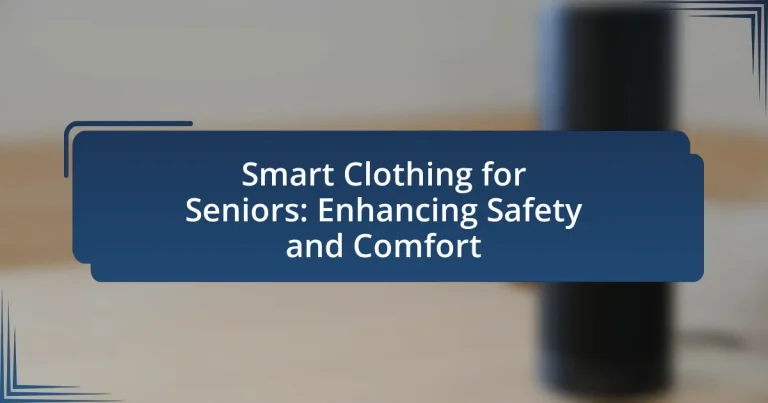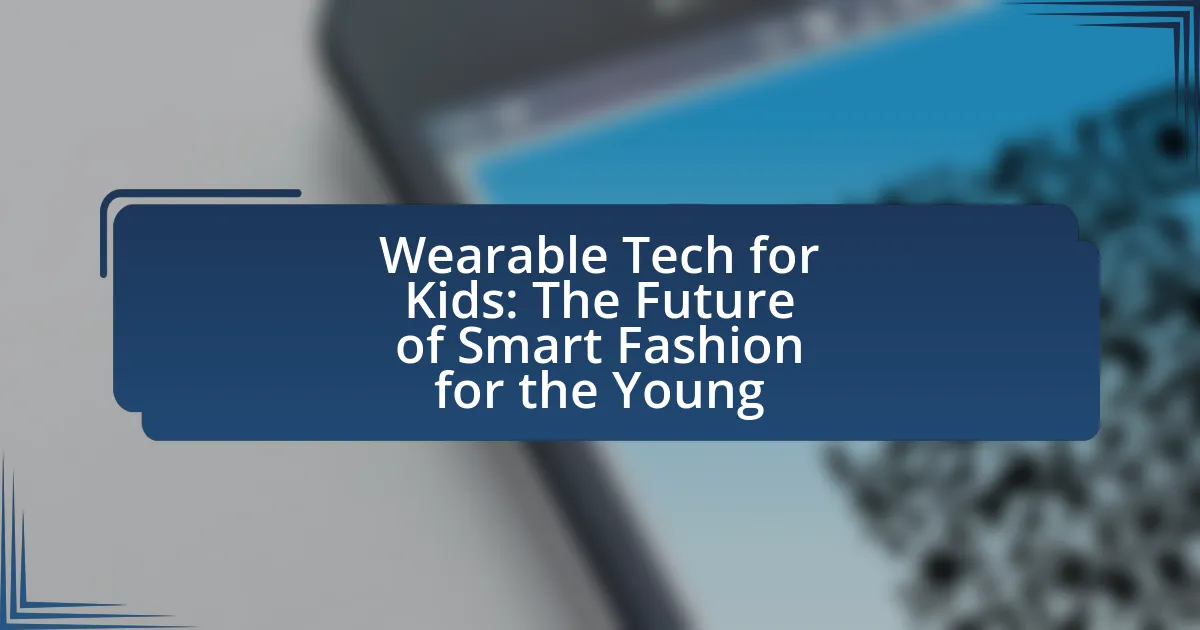Smart clothing for seniors refers to technologically advanced garments designed to monitor health metrics and enhance safety for older adults. These garments incorporate features such as sensors for tracking vital signs, GPS for location monitoring, and fall detection systems, which collectively improve the quality of life for seniors by facilitating timely medical interventions. The article explores the various technologies integrated into smart clothing, the importance of comfort and fit, and the benefits these innovations provide, including enhanced safety, independence, and health monitoring. Additionally, it addresses challenges related to user acceptance and privacy concerns, offering best practices for selecting suitable smart clothing for seniors.

What is Smart Clothing for Seniors?
Smart clothing for seniors refers to wearable garments equipped with technology that monitors health metrics and enhances safety. These garments can include features such as sensors that track vital signs like heart rate and temperature, as well as GPS for location tracking, which can be crucial for seniors who may experience mobility issues or cognitive decline. Research indicates that smart clothing can significantly improve the quality of life for older adults by providing real-time health data to caregivers and family members, thereby facilitating timely medical interventions when necessary.
How does smart clothing enhance safety for seniors?
Smart clothing enhances safety for seniors by integrating technology that monitors vital signs and detects falls. These garments often include sensors that track heart rate, body temperature, and movement patterns, allowing for real-time health monitoring. For instance, a study published in the Journal of Medical Internet Research found that wearable devices can significantly reduce emergency response times by alerting caregivers immediately when a fall is detected. This proactive approach not only helps in timely medical intervention but also provides seniors with a sense of security, knowing that help is readily available.
What technologies are integrated into smart clothing for safety?
Smart clothing for safety integrates technologies such as sensors, GPS tracking, and communication devices. These sensors can monitor vital signs like heart rate and temperature, providing real-time health data. GPS tracking enables location monitoring, which is crucial for seniors who may wander or require assistance. Communication devices, including emergency alert systems, allow users to contact caregivers or emergency services quickly. These technologies collectively enhance safety by providing immediate health insights and facilitating timely responses in emergencies.
How do these technologies monitor health and safety?
Smart clothing technologies monitor health and safety by integrating sensors that track vital signs, movement, and environmental conditions. These sensors can measure heart rate, body temperature, and activity levels, providing real-time data to caregivers or medical professionals. For instance, a study published in the Journal of Medical Internet Research found that wearable devices can effectively detect falls and alert emergency services, significantly improving response times and outcomes for seniors. Additionally, smart fabrics can monitor hydration levels and detect changes in skin temperature, which are critical for preventing heat-related illnesses.
What role does comfort play in smart clothing for seniors?
Comfort is essential in smart clothing for seniors as it directly influences their willingness to wear and utilize these garments. Comfortable smart clothing encourages regular use, which is crucial for the effectiveness of embedded technologies designed to monitor health and safety. Research indicates that seniors are more likely to adopt wearable technology when it feels good against their skin and allows for ease of movement, thereby enhancing their overall quality of life. For instance, a study published in the Journal of Textile Science and Technology found that comfort significantly affects user satisfaction and compliance with wearable devices among older adults.
What materials are used to ensure comfort in smart clothing?
Smart clothing for seniors utilizes materials such as moisture-wicking fabrics, soft cotton blends, and stretchable textiles to ensure comfort. Moisture-wicking fabrics help to keep the skin dry by drawing sweat away, while soft cotton blends provide a gentle touch against the skin, reducing irritation. Stretchable textiles allow for ease of movement, accommodating the physical activities of seniors. These materials are specifically chosen to enhance comfort, which is crucial for the well-being of older adults who may have sensitive skin or mobility issues.
How does fit and design impact the comfort of smart clothing?
Fit and design significantly impact the comfort of smart clothing by ensuring that garments conform to the body while accommodating embedded technology. A well-fitted design prevents chafing and restricts movement, which is crucial for seniors who may have limited mobility. Additionally, the choice of materials in the design influences breathability and moisture-wicking properties, enhancing overall comfort during wear. Research indicates that clothing designed with ergonomic principles can improve user satisfaction and reduce discomfort, particularly in populations with specific needs, such as seniors.

What are the key features of smart clothing for seniors?
Smart clothing for seniors incorporates features such as health monitoring, fall detection, and temperature regulation. These garments often include embedded sensors that track vital signs like heart rate and body temperature, providing real-time health data to caregivers or medical professionals. Additionally, many smart clothing options are designed with fall detection technology, which can alert emergency services if a fall occurs, enhancing safety. Temperature regulation features help maintain comfort by adjusting to environmental changes, ensuring seniors remain at a comfortable temperature. These functionalities collectively contribute to improved safety and comfort for elderly individuals, making smart clothing a valuable innovation in senior care.
What types of sensors are commonly found in smart clothing?
Smart clothing commonly incorporates sensors such as accelerometers, gyroscopes, heart rate monitors, temperature sensors, and pressure sensors. Accelerometers and gyroscopes track movement and orientation, providing data on physical activity and stability, which is crucial for seniors to prevent falls. Heart rate monitors measure cardiovascular health, while temperature sensors help in monitoring body temperature for signs of illness. Pressure sensors can detect posture and pressure points, enhancing comfort and safety. These sensors collectively contribute to the functionality of smart clothing, making it a valuable tool for enhancing safety and comfort for seniors.
How do motion sensors contribute to safety?
Motion sensors enhance safety by detecting movement and triggering alerts in real-time, which is particularly beneficial for seniors. These sensors can monitor an individual’s activity levels and detect falls or unusual behavior, allowing for immediate assistance. For instance, studies show that fall detection systems using motion sensors can reduce emergency response times significantly, improving outcomes for seniors who may be incapacitated. Additionally, integrating motion sensors into smart clothing can provide continuous monitoring, ensuring that caregivers are alerted promptly in case of emergencies, thereby enhancing overall safety and peace of mind for both seniors and their families.
What health monitoring capabilities do these sensors provide?
These sensors provide health monitoring capabilities such as heart rate tracking, body temperature measurement, and activity level assessment. Specifically, heart rate sensors can continuously monitor cardiovascular health, while temperature sensors help detect fever or hypothermia. Additionally, accelerometers assess physical activity, enabling the detection of falls or changes in mobility. These functionalities are crucial for seniors, as they facilitate timely medical interventions and promote overall well-being.
How does smart clothing communicate with caregivers or family members?
Smart clothing communicates with caregivers or family members through embedded sensors that monitor vital signs and activity levels, transmitting data via wireless technology. These garments often utilize Bluetooth or Wi-Fi to send real-time information to connected devices, such as smartphones or tablets, allowing caregivers to receive alerts about health changes, falls, or unusual activity patterns. For instance, a study published in the Journal of Medical Internet Research highlights that smart textiles can effectively relay heart rate and movement data, enabling timely interventions when necessary.
What technologies enable communication and alerts?
Technologies that enable communication and alerts in smart clothing for seniors include wireless communication protocols, sensors, and mobile applications. Wireless communication protocols such as Bluetooth and Wi-Fi facilitate real-time data transmission between the clothing and connected devices, allowing for immediate alerts to caregivers or family members. Sensors embedded in the clothing can monitor vital signs, detect falls, or assess environmental conditions, triggering alerts when predefined thresholds are exceeded. Mobile applications serve as user interfaces for caregivers, providing notifications and updates based on the data collected from the smart clothing. These technologies collectively enhance safety and comfort for seniors by ensuring timely communication and response in critical situations.
How can caregivers access data from smart clothing?
Caregivers can access data from smart clothing through dedicated mobile applications or web platforms provided by the clothing manufacturers. These applications typically connect to the smart clothing via Bluetooth or Wi-Fi, allowing caregivers to monitor health metrics such as heart rate, temperature, and activity levels in real-time. For instance, companies like Hexoskin and Owlet offer platforms that aggregate data from their smart garments, enabling caregivers to receive alerts and insights about the wearer’s health status. This direct access to data enhances the ability of caregivers to respond promptly to any health concerns.

What are the benefits of using smart clothing for seniors?
Smart clothing for seniors offers numerous benefits, primarily enhancing safety and comfort. These garments often incorporate sensors that monitor vital signs, such as heart rate and body temperature, allowing for real-time health tracking. For instance, a study published in the Journal of Medical Internet Research found that wearable technology can significantly improve health outcomes by enabling early detection of potential health issues. Additionally, smart clothing can provide alerts for falls or unusual movements, which is crucial for seniors living independently. This technology not only promotes a sense of security but also encourages active lifestyles, as seniors can engage in daily activities with the reassurance that their health is being monitored.
How does smart clothing improve the quality of life for seniors?
Smart clothing improves the quality of life for seniors by integrating technology that enhances safety, comfort, and health monitoring. These garments can monitor vital signs such as heart rate and temperature, alerting caregivers to potential health issues in real-time. For instance, a study published in the Journal of Medical Internet Research found that wearable health technology significantly increased the ability to detect health changes early, thereby reducing emergency situations. Additionally, smart clothing can provide features like fall detection and GPS tracking, which contribute to greater independence and peace of mind for both seniors and their families.
What specific health outcomes can be enhanced by smart clothing?
Smart clothing can enhance specific health outcomes such as monitoring vital signs, improving mobility, and preventing falls in seniors. These garments often incorporate sensors that track heart rate, body temperature, and activity levels, providing real-time health data that can alert caregivers to potential issues. For instance, a study published in the Journal of Medical Internet Research found that wearable technology significantly reduced fall rates among older adults by providing timely alerts and feedback on their movements. Additionally, smart clothing can facilitate rehabilitation by offering support and feedback during physical activities, thereby enhancing overall physical health and well-being.
How does smart clothing promote independence among seniors?
Smart clothing promotes independence among seniors by integrating technology that enhances their safety and mobility. These garments often include features such as sensors that monitor vital signs, detect falls, and provide real-time health data, allowing seniors to maintain their autonomy while ensuring immediate assistance if needed. For instance, a study published in the Journal of Medical Internet Research found that wearable health monitoring devices significantly improved the confidence and independence of older adults by providing them with timely health information and alerts. This technology empowers seniors to engage in daily activities with reduced fear of accidents or health emergencies, thereby fostering a greater sense of independence.
What challenges are associated with the adoption of smart clothing?
The challenges associated with the adoption of smart clothing include technological limitations, user acceptance, and privacy concerns. Technological limitations refer to issues such as battery life, durability, and the integration of sensors into fabrics, which can hinder functionality. User acceptance is critical, as seniors may be resistant to adopting new technologies due to unfamiliarity or perceived complexity. Privacy concerns arise from the collection and transmission of personal health data, leading to apprehension about data security and misuse. These challenges must be addressed to facilitate the successful integration of smart clothing into the lives of seniors.
What are the common barriers to acceptance among seniors?
Common barriers to acceptance among seniors regarding smart clothing include technological apprehension, perceived complexity, and concerns about privacy. Many seniors may feel intimidated by new technology, leading to reluctance in adopting smart clothing solutions. Research indicates that 60% of older adults express discomfort with technology, fearing it may be too complicated to use effectively. Additionally, seniors often worry about how their personal data will be handled, with studies showing that 70% of older adults are concerned about privacy issues related to wearable devices. These factors collectively hinder the widespread acceptance of smart clothing designed to enhance safety and comfort for seniors.
How can these challenges be addressed effectively?
To address the challenges of smart clothing for seniors effectively, manufacturers should focus on user-friendly designs, robust technology integration, and comprehensive testing. User-friendly designs ensure that seniors can easily wear and operate the clothing, which is crucial for adoption. Robust technology integration, such as reliable sensors and connectivity, enhances functionality and safety, allowing for real-time health monitoring and alerts. Comprehensive testing with actual users helps identify usability issues and ensures that the clothing meets the specific needs of seniors. Research indicates that user-centered design significantly improves product acceptance among older adults, as seen in studies conducted by the University of Southern California, which highlighted the importance of usability in wearable technology for seniors.
What are the best practices for selecting smart clothing for seniors?
The best practices for selecting smart clothing for seniors include prioritizing comfort, ease of use, and functionality. Comfort is essential as seniors may have sensitive skin or mobility issues; therefore, materials should be soft, breathable, and non-restrictive. Ease of use is crucial; clothing should feature simple fastenings and adjustable elements to accommodate varying levels of dexterity. Functionality is also important; smart clothing should incorporate health-monitoring technology, such as heart rate sensors or fall detection, to enhance safety. Research indicates that wearable technology can significantly improve health outcomes for seniors by providing real-time data to caregivers and medical professionals.





